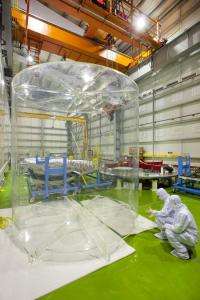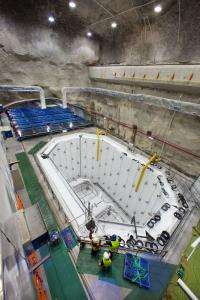The Daya Bay Reactor Neutrino Experiment: On track to completion

Berkeley Lab physicists and engineers are among the leaders of the unique Daya Bay Reactor Neutrino Experiment, where Chinese and American scientists, with colleagues from Russia, Taiwan, and the Czech Republic, have come together to investigate a peculiar phenomenon related to so-called neutrino mixing. Kam-Biu Luk of Berkeley Lab’s Physics Division is Daya Bay’s scientific co-spokesperson, with Yifang Wang of Beijing’s Institute of High Energy Physics. Bill Edwards of the Lab’s Physics Division is the U.S. Project and Operations Manager.
What the researchers find at Daya Bay will bear on some of the most intriguing questions in basic physics: how much do different kinds of neutrinos weigh? And which kind is the heaviest? By weighing neutrinos scientists hope to learn how electrons and their cousins, muons and tau particles, came into existence in the moments after the big bang. The answers could explain why there is more matter than antimatter in the universe – and indeed why there is any matter at all.

Clues to neutrino mass lie in measuring how one “flavor” of neutrino changes into another. (Electron neutrinos, muon neutrinos, and tau neutrinos, the three flavors, are named after the leptons with which each is associated.) The crucial value, written θ13, is a term known as “neutrino mixing angle theta one three” – and the Daya Bay experiment is intended to measure it to within a few degrees. The following tour of the experimental site shows how the researchers hope to do it.
Provided by Lawrence Berkeley National Laboratory
















